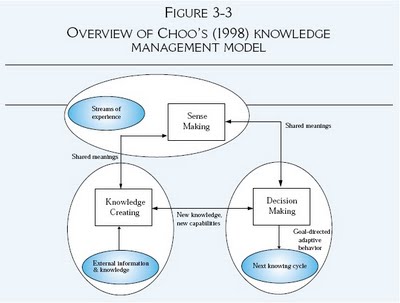The Choo Sense-Making KM Model
|
The Choo Sense-Making KM Model (1998) stresses sense making, knowledge creation and decision making. Choo (1998) asserts that the “knowing organizations” are those which use information strategically in the context of three arenas, namely, (a) sense making, (b) knowledge creation and (c) decision making. These three highly interconnected processes play a strategic role as to the unfoldment of the organization’s knowledge vision, it’s potential to knowledge creation and its commitment into taking knowledge creation to the utmost consequences (Neto et al, 2009, p.595). Concerning Sense making, its long term goal is the warranty that organizations will adapt and continue to prosper in a dynamic and complex environment through activities of prospecting and interpretation of relevant information enabling it to understand changes, trends and scenarios about clients, suppliers, competitors and other external environment actors. Organizations face issues such as the reduction of uncertainty and the management of ambiguity (Neto et al, 2009, p.595). Knowledge creation is a process that allows an organization to create or acquire, organize and process information in order to generate new knowledge through organizational learning (Neto et al, 2009, p.595). |
 |
| The new knowledge generated, in its turn, allows the organization to develop new abilities and capabilities, create new products and new services, improve the existing ones and redesign its organizational processes. This process reveals the organization “potential to act” (Neto et al, 2009, p.595). |
Figure: The Choo Sense-Making KM Model (1998) Source: http://kmpedia.wikispaces.com/file/view/333.jpg/284002712/333.jpg |
The third component of Choo’s (1998) model involves decision-making. The organization must choose the best option among those that are plausible and presented and pursue it based on the organization’s strategy. Decision making process in organizations is constrained by the bounded rationality principle, as advocated by March & Simon (1975) (Neto et al, 2009, p.595).
Licensed under the Creative Commons Attribution Non-commercial No Derivatives 3.0 License